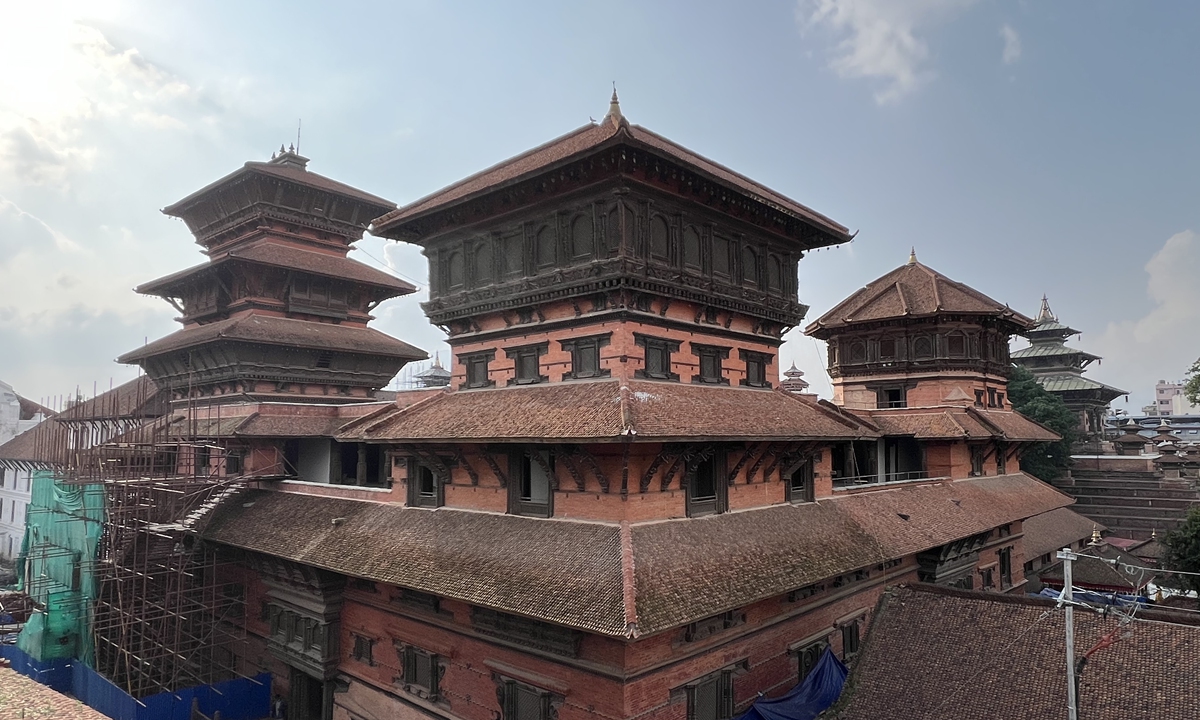
The Basantapur Palace in Kathmandu Durbar Square Photo: Courtesy of the CACH
The morning sun illuminates the intricate stone bricks of Durbar Square, bringing the exquisite stone carvings on the 18th-century palace walls to life.
My fingers gently touch the newly restored wooden doors, their surface warm and vivid — as if they had just awakened from a masterful surgery. The carved patterns tell a story: the meeting of ancient Nepali woodcarving craftsmanship with the new restoration technology from China — flexible steel cables that invisibly reinforce the structure of this ancient building as it recovers from the devastating earthquake.
The nine-story Basantapur Tower is not just a building; it's Nepal's cultural DNA. This mid-18th-century pagoda-style structure suffered extensive damage in the 2015 earthquake.
Today, as I look up at the 30-meter-tall temple supported by several thousand meticulously restored wooden components, I am witnessing a miracle stitched together by two civilizations.
In Nepal's search for funding and technology to repair this ancient structure after the earthquake, the answer came from across the Himalayas.
In 2017, China's National Cultural Heritage Administration sent a team that resembled a tech startup more than traditional restorers. They brought laser scanners, high-tech structural analysis software, and a philosophy: "Don't just fix the surface, strengthen the bones."
The most revolutionary intervention went unseen: flexible steel tendons running through hollowed-out pillars enabled the structure to sway safely during an earthquake.
Western narratives often simplify the Belt and Road Initiative (BRI) as a program focused on ports, railroads and pipelines. But here, in this UNESCO World Heritage Site, I saw a different currency of influence. The restoration cost pales compared to the value of knowledge transfer: Nepali restorers were trained in seismic retrofitting and 3D modeling through workshops conducted in both Chinese and Nepali.
Chinese and Nepali workers were not simply restoring old buildings, they were preserving the essence of an ancient civilization. They worked to capture the smell of sandalwood during the monsoon rains and the precise angle of sunlight touching the fifth-floor goddess during the winter solstice.
This dance between tradition and innovation, fostered by the BRI, offers a robust response to those who seek to attack the BRI and stoke fears of the so-called China threat. It is a powerful demonstration of the transformative power of cultural exchange, showing that it is no longer just an extension of roads or the expansion of power grids — it is the resonance that cultural exchanges create. If such exchanges can cross the Himalayas, they can transcend far greater distances, enlightening us all.
A key aspect of China's heritage conservation work under its 14th Five-Year Plan is technological innovation. This is not merely a technical export but an effort to advance the protection of humanity's shared cultural heritage. More Chinese heritage workers are venturing abroad, bringing China's advanced techniques to the world, while more international conservationists are coming to China to learn its preservation principles and methods.
International cooperation in cultural heritage has consistently been highlighted in key meetings between heads of state and in multilateral and bilateral agreements. The international governance capabilities in the cultural heritage field are constantly strengthening, achieving institutional power within all international organizations related to cultural heritage and achieving full coverage of senior positions. Cultural exchanges and cooperation with countries along the "Belt and Road" are also on the rise, with dozens of foreign aid projects for cultural heritage protection forming an expanding network in neighboring countries.
Heritage conservation has become a bridge connecting China with Belt and Road countries and the world, deepening mutual understanding and emotional connections.
This may be the untold story of the BRI: it is not about China reshaping the world but rather about China using its accumulated expertise and experience to articulate the importance of cultural exchange.
As the morning winds of the Himalayas carry the metallic whispers of temple bells, I recall a profound insight: "Civilizations become enriched through exchanges and thrive through mutual learning."
In an era when hegemonic forces increasingly fracture geopolitics, cultural preservation offers a vital communication bridge. It reminds us that a nation's soft power is not about domination; rather, it is about ensuring that a Nepali child a hundred years from now can experience the same feeling when touching the sun-warmed wood I touched today and marvel at how two nations once inscribed hope into the grain of that wood.
It is about preserving our shared cultural heritage, which connects us all.
The author is a senior editor with the People's Daily, and currently a senior fellow with the Chongyang Institute for Financial Studies at the Renmin University of China. dinggang@globaltimes.com.cn. Follow him on X @dinggangchina




